Tiltmeter Data Revealing Transient Magma Viscosity Changes During Eruptions
Abstract
:1. Introduction
2. Materials and Methods
2.1. La Palma (2021) and El Hierro (2011–2012) Eruptions
| Description | Symbol | Values | |
|---|---|---|---|
| Model Variables | La Palma (2021) | El Hierro (2011) | |
| Horizontally averaged vertical velocity | w | 0.17–0.49 m·s−1 [21] | - |
| Crystal concentration per volume | β | 0.4 [16] | |
| Critical crystal concentration per volume | 0.7 [16] | ||
| Geometrical parameters | |||
| Vertical distance between both chambers | L | 5 km [25] | 7 km [19] |
| Radius of the feeding conduit | a | ~48 m [25] | - |
| Magma properties | |||
| Viscosity | μ | 2.3 × 104–14.7·104 Pa·s [21] | 0.1 × 102–3.16 × 102 Pa·s [18,19] |
| Density | ρ | 2650–2700 kg·m−3 [21,25] | 2650–2800 kg·m−3 [19,31] |
| Crystal growth rate | χ | 10–12 m·s−1 [17] | |
| Number density of crystals | nch | 1.8 × 1014 m−3–7 × 1014 m−3 [21,32] | |
| Storage zone properties | |||
| Volume of the top storage zone | Vt | ~3.75 × 107 m3 [25] | ~2 × 108 m3 [19] |
| Volume of the bottom storage zone | Vb | ~3 × 107 m3 [25] | - |
| Feeding volumetric flux | Q | ~27 m3·s−1 (this work) | ~26 m3·s−1 [30] |
| Young’s modulus | E | 1–10 GPa [25] | 30 GPa [19] |
2.2. Geodetic Data
2.3. Analysis of the Time Series of Tiltmeter Data
2.3.1. Multichannel Singular Spectrum Analysis (M-SSA)
2.3.2. Monte Carlo M-SSA (MC-MSSA)
2.4. Description of the Physical Model
3. Results of the Analysis of the Time-Series Tiltmeter Data
3.1. La Palma Data
3.1.1. Choice of Window Length
3.1.2. Statistical Significance of the Extracted Modes and Signal Reconstruction
3.2. El Hierro Data
3.2.1. Choice of Window Length
3.2.2. Statistical Significance of the Extracted Modes and Signal Reconstruction
4. Application of the Physical Model to the Cyclic Tilt Signal
- To constrain the range of realistic values for the four dimensionless parameters using available geological and geophysical information: For the cases of La Palma and El Hierro eruptions, Table 1 lists all available information, and more details are given in Section 2.1. For instance, the range of magma viscosity values for La Palma eruptions, based on published data, is 2.3 × 104–14.7 × 104 Pa·s, while for El Hierro, it is 0.1 × 102–3.16 × 102 Pa·s. Similarly, magma density values reported in the literature range from 2650 to 2700 kg·m−3 for La Palma and from 2650 to 2800 kg·m−3 for El Hierro.
- To generate a complete set of potential model solutions for the cyclic signals using the model described in Section 2.4: For the case of La Palma, the ranges of values are µ★ = 4–6.5, V★ = 1–1.5, γ = 0.15–0.25, and Q★ = 2–2.5. For the case of El Hierro, the ranges of values are µ★ = 28–38, V★ = 0.5–1, γ = 0.0018–0.0033, and Q★ = 1–2. Subsequently, a step value is established for each range of values. The finer the step value is, the greater the accuracy of the solution will be, albeit at the cost of exponentially increasing the computational time. Thus, we obtained up to 160,000 different solutions of the physical model by using 20 different values for each range of the four variables.
- To identify the solution that best replicates the period of the oscillations, regardless of the amplitude values, by comparing the obtained solution with the observed cyclic signal for each possible combination of the four parameters: To assess the tilt variation period against that of the velocity (and pressure) pulses, we devised a cost function to calculate the normalized cross-correlation value between the observed and modelled cyclic signals. Then, we selected the combination of the four dimensionless parameters exhibiting the highest cross-correlation value as the optimal solution that characterizes the cyclic behavior of the system.
- Several graphs displaying the results of the cost function help identify the best solution. As it is not feasible to display the values of the normalized cross-correlation for all four variables simultaneously, two different graphs show the results for each eruption. The first graph displays the results of the cost function for the range of possible values of µ★ and γ corresponding to the best pair of values V★ and Q★. The second one displays the results of the cost function for the range of possible values of V★ and Q★ corresponding to the best pair of values µ★ and γ.
5. Cyclic Signals and Subsurface Mass Variation
6. Geological Interpretation of the Cyclic Tilts
7. Conclusions
Supplementary Materials
Author Contributions
Funding
Data Availability Statement
Acknowledgments
Conflicts of Interest
References
- Sparks, R.S.J.; Biggs, J.; Neuberg, J.W. Monitoring Volcanoes. Science 2012, 335, 1310–1311. [Google Scholar] [CrossRef] [PubMed]
- Gambino, S.; Falzone, G.; Ferro, A.; Laudani, G. Volcanic processes detected by tiltmeters: A review of experience on Sicilian volcanoes. J. Volcanol. Geotherm. Res. 2014, 271, 43–54. [Google Scholar] [CrossRef]
- Aloisi, M.; Bonaccorso, A.; Gambino, S.; Mattia, M.; Puglisi, G. Etna 2002 eruption imaged from continuous tilt and GPS data. Geophys. Res. Lett. 2003, 30. [Google Scholar] [CrossRef]
- Bruno, V.; Aloisi, M.; Gambino, S.; Mattia, M.; Ferlito, C.; Rossi, M. The Most Intense Deflation of the Last Two Decades at Mt. Etna: The 2019–2021 Evolution of Ground Deformation and Modeled Pressure Sources. Geophys. Res. Lett. 2022, 49, e2021GL095195. [Google Scholar] [CrossRef]
- Peltier, A.; Famin, V.; Bachèlery, P.; Cayol, V.; Fukushima, Y.; Staudacher, T. Cyclic magma storages and transfers at Piton de La Fournaise volcano (La Réunion hotspot) inferred from deformation and geochemical data. Earth Planet. Sci. Lett. 2008, 270, 180–188. [Google Scholar] [CrossRef]
- Walwer, D.; Ghil, M.; Calais, E. Oscillatory nature of the Okmok volcano’s deformation. Earth Planet. Sci. Lett. 2019, 506, 76–86. [Google Scholar] [CrossRef]
- Xue, X.; Freymueller, J.; Lu, Z. Modeling the Posteruptive Deformation at Okmok Based on the GPS and InSAR Time Series: Changes in the Shallow Magma Storage System. J. Geophys. Res. Solid Earth 2020, 125, e2019JB017801. [Google Scholar] [CrossRef]
- Voight, B.; Hoblitt, R.P.; Clarke, A.B.; Lockhart, A.B.; Miller, A.D.; Lynch, L.; McMahon, J. Remarkable cyclic ground deformation monitored in real-time on Montserrat, and its use in eruption forecasting. Geophys. Res. Lett. 1998, 25, 3405–3408. [Google Scholar] [CrossRef]
- de’ Michieli Vitturi, M.; Clarke, A.B.; Neri, A.; Voight, B. Extrusion cycles during dome-building eruptions. Earth Planet. Sci. Lett. 2013, 371–372, 37–48. [Google Scholar] [CrossRef]
- Anderson, K.; Lisowski, M.; Segall, P. Cyclic ground tilt associated with the 2004–2008 eruption of Mount St. Helens. J. Geophys. Res. 2010, 115. [Google Scholar] [CrossRef]
- Takeo, M.; Maehara, Y.; Ichihara, M.; Ohminato, T.; Kamata, R.; Oikawa, J. Ground deformation cycles in a magma-effusive stage, and sub-Plinian and Vulcanian eruptions at Kirishima volcanoes, Japan. J. Geophys. Res. Solid Earth 2013, 118, 4758–4773. [Google Scholar] [CrossRef]
- Fujita, E.; Ukawa, M.; Yamamoto, E. Subsurface cyclic magma sill expansions in the 2000 Miyakejima volcano eruption: Possibility of two-phase flow oscillation. J. Geophys. Res. 2004, 109. [Google Scholar] [CrossRef]
- Nakanishi, M.; Koyaguchi, T. A stability analysis of a conduit flow model for lava dome eruptions. J. Volcanol. Geotherm. Res. 2008, 178, 46–57. [Google Scholar] [CrossRef]
- Kanno, Y.; Ichihara, M. Sawtooth wave-like pressure changes in a syrup eruption experiment: Implications for periodic and nonperiodic volcanic oscillations. Bull. Volcanol. 2018, 80, 65. [Google Scholar] [CrossRef]
- Whitehead, J.A.; Helfrich, K.R. Instability of flow with temperature-dependent viscosity: A model of magma dynamics. J. Geophys. Res. 1991, 96, 4145–4155. [Google Scholar] [CrossRef]
- Barmin, A.; Melnik, O.; Sparks, R.S.J. Periodic behavior in lava dome eruptions. Earth Planet. Sci. Lett. 2002, 199, 173–184. [Google Scholar] [CrossRef]
- Walwer, D.; Ghil, M.; Calais, E. A Data-Based Minimal Model of Episodic Inflation Events at Volcanoes. Front. Earth Sci. 2022, 10, 759475. [Google Scholar] [CrossRef]
- Martí, J.; Castro, A.; Rodriguez, C.; Costa, F.; Carrasquilla, S.; Pedreira, R.; Bolos, X. Correlation of Magma Evolution and Geophysical Monitoring during the 2011–2012 El Hierro (Canary Islands) Submarine Eruption. J. Petrol. 2013, 54, 1349–1373. [Google Scholar] [CrossRef]
- Martí, J.; Pinel, V.; López, C.; Geyer, A.; Abella, R.; Tárraga, M.; Blanco, M.J.; Castro, A.; Rodríguez, C. Causes and mechanisms of the 2011–2012 El Hierro (Canary Islands) submarine eruption. J. Geophys. Res. Solid Earth 2013, 118, 823–839. [Google Scholar] [CrossRef]
- Castro, J.M.; Feisel, Y. Eruption of ultralow-viscosity basanite magma at Cumbre Vieja, La Palma, Canary Islands. Nat. Commun. 2022, 13, 3174. [Google Scholar] [CrossRef] [PubMed]
- Romero, J.E.; Burton, M.; Cáceres, F.; Taddeucci, J.; Civico, R.; Ricci, T.; Pankhurst, M.J.; Hernández, P.A.; Bonadonna, C.; Llewellin, E.W.; et al. The initial phase of the 2021 Cumbre Vieja ridge eruption (Canary Islands): Products and dynamics controlling edifice growth and collapse. J. Volcanol. Geotherm. Res. 2022, 431, 107642. [Google Scholar] [CrossRef]
- Mapa de Evolución de la Lava Entre el 24-11-2021 y el 14-12-2021. Available online: http://info.igme.es/eventos/Erupcion-volcanica-la-palma/visores-mapas (accessed on 29 May 2024).
- Civico, R.; Ricci, T.; Scarlato, P.; Taddeucci, J.; Andronico, D.; Del Bello, E.; D’Auria, L.; Hernández, P.A.; Pérez, N.M. High-resolution Digital Surface Model of the 2021 eruption deposit of Cumbre Vieja volcano, La Palma, Spain. Sci. Data 2022, 9, 435. [Google Scholar] [CrossRef]
- De Luca, C.; Valerio, E.; Giudicepietro, F.; Macedonio, G.; Casu, F.; Lanari, R. Pre- and Co-Eruptive Analysis of the September 2021 Eruption at Cumbre Vieja Volcano (La Palma, Canary Islands) Through DInSAR Measurements and Analytical Modeling. Geophys. Res. Lett. 2022, 49, e2021GL097293. [Google Scholar] [CrossRef]
- Montesinos, F.G.; Sainz-Maza, S.; Gomez-Ortiz, D.; Arnoso, J.; Blanco-Montenegro, I.; Benavent, M.; Vélez, E.; Sánchez, N.; Martín-Crespo, T. Insights into the Magmatic Feeding System of the 2021 Eruption at Cumbre Vieja (La Palma, Canary Islands) Inferred from Gravity Data Modeling. Remote Sens. 2023, 15, 1936. [Google Scholar] [CrossRef]
- Ubide, T.; Márquez, A.; Ancochea, E.; Huertas, M.J.; Herrera, R.; Coello-Bravo, J.; Sanz-Mangas, D.; Mulder, J.; MacDonald, A.; Galindo, I. Discrete magma injections drive the 2021 La Palma eruption. Sci. Adv. 2023, 9, eadg4813. [Google Scholar] [CrossRef] [PubMed]
- Bonadonna, C.; Pistolesi, M.; Biass, S.; Voloschina, M.; Romero, J.; Coppola, D.; Folch, A.; D’Auria, L.; Martin-Lorenzo, A.; Dominguez, L.; et al. Physical Characterization of Long-Lasting Hybrid. Eruptions: The 2021 Tajogaite Eruption of Cumbre Vieja (La Palma, Canary Islands). J. Geophys. Res. Solid Earth 2022, 127, e2022JB025302. [Google Scholar] [CrossRef]
- Plank, S.; Shevchenko, A.V.; d’Angelo, P.; Gstaiger, V.; González, P.J.; Cesca, S.; Martinis, S.; Walter, T.R. Combining thermal, tri-stereo optical and bi-static InSAR satellite imagery for lava volume estimates: The 2021 Cumbre Vieja eruption, La Palma. Sci. Rep. 2023, 13, 2057. [Google Scholar] [CrossRef]
- López, C.; Blanco, M.J.; Abella, R.; Brenes, B.; Cabrera Rodríguez, V.M.; Casas, B.; Domínguez Cerdeña, I.; Felpeto, A.; de Villalta, M.F.; del Fresno, C.; et al. Monitoring the volcanic unrest of El Hierro (Canary Islands) before the onset of the 2011–2012 submarine eruption. Geophys. Res. Lett. 2012, 39. [Google Scholar] [CrossRef]
- Rivera, J.; Lastras, G.; Canals, M.; Acosta, J.; Arrese, B.; Hermida, N.; Micallef, A.; Tello, O.; Amblas, D. Construction of an oceanic island: Insights from the El Hierro (Canary Islands) 2011–2012 submarine volcanic eruption. Geology 2013, 41, 355–358. [Google Scholar] [CrossRef]
- Becerril, L.; Galindo, I.; Gudmundsson, A.; Morales, J.M. Depth of origin of magma in eruptions. Sci. Rep. 2013, 3, 2762. [Google Scholar] [CrossRef] [PubMed]
- Cashman, K.V.; Blundy, J. Degassing and crystallization of ascending andesite and dacite. Philos. Trans. R. Soc. Lond. Ser. A Math. Phys. Eng. Sci. 2000, 358, 1487–1513. [Google Scholar] [CrossRef]
- Biggs, J.; Pritchard, M.E. Global Volcano Monitoring: What Does It Mean When Volcanoes Deform? Elements 2017, 13, 17–22. [Google Scholar] [CrossRef]
- Ghil, M.; Allen, M.R.; Dettinger, M.D.; Ide, K.; Kondrashov, D.; Mann, M.E.; Robertson, A.W.; Saunders, A.; Tian, Y.; Varadi, F.; et al. Advanced spectral methods for climatic time series. Rev. Geophys. 2002, 40, 3–41. [Google Scholar] [CrossRef]
- Groth, A.; Ghil, M. Monte Carlo Singular Spectrum Analysis (SSA) Revisited: Detecting Oscillator Clusters in Multivariate Datasets. J. Clim. 2015, 28, 7873–7893. [Google Scholar] [CrossRef]
- Alessio, S.M. Singular Spectrum Analysis (SSA). In Digital Signal Processing and Spectral Analysis for Scientists: Concepts and Applications; Alessio, S.M., Ed.; Springer International Publishing: Cham, Switzerland, 2016; pp. 537–571. [Google Scholar]
- Vautard, R.; Ghil, M. Singular spectrum analysis in nonlinear dynamics, with applications to paleoclimatic time series. Phys. D 1989, 35, 395–424. [Google Scholar] [CrossRef]
- Vautard, R.; Yiou, P.; Ghil, M. Singular-spectrum analysis: A toolkit for short, noisy chaotic signals. Phys. D 1992, 58, 95–126. [Google Scholar] [CrossRef]
- Ghil, M.; Vautard, R. Interdecadal oscillations and the warming trend in global temperature time series. Nature 1991, 350, 324–327. [Google Scholar] [CrossRef]
- Chen, Q.; van Dam, T.; Sneeuw, N.; Collilieux, X.; Weigelt, M.; Rebischung, P. Singular spectrum analysis for modeling seasonal signals from GPS time series. J. Geodyn. 2013, 72, 25–35. [Google Scholar] [CrossRef]
- Wang, X.; Cheng, Y.; Wu, S.; Zhang, K. An enhanced singular spectrum analysis method for constructing nonsecular model of GPS site movement. J. Geophys. Res. Solid Earth 2016, 121, 2193–2211. [Google Scholar] [CrossRef]
- Walwer, D.; Calais, E.; Ghil, M. Data-adaptive detection of transient deformation in geodetic networks. J. Geophys. Res. Solid Earth 2016, 121, 2129–2152. [Google Scholar] [CrossRef]
- Dettinger, M.D.; Ghil, M.; Strong, C.M.; Weibel, W.; Yiou, P. Software expedites singular-spectrum analysis of noisy time series. Eos Trans. Am. Geophys. Union 1995, 76, 12–21. [Google Scholar] [CrossRef]
- Allen, M.R.; Smith, L.A. Investigating the origins and significance of low-frequency modes of climate variability. Geophys. Res. Lett. 1994, 21, 883–886. [Google Scholar] [CrossRef]
- Theiler, J.; Eubank, S.; Longtin, A.; Galdrikian, B.; Doyne Farmer, J. Testing for nonlinearity in time series: The method of surrogate data. Phys. D 1992, 58, 77–94. [Google Scholar] [CrossRef]
- Ida, Y. Cyclic fluid effusion accompanied by pressure change: Implication for volcanic eruptions and tremor. Geophys. Res. Lett. 1996, 23, 1457–1460. [Google Scholar] [CrossRef]
- Wylie, J.; Voight, B.; Whitehead, J. Instability of Magma Flow from Volatile-Dependent Viscosity. Science 1999, 285, 1883–1885. [Google Scholar] [CrossRef]
- Maeda, I. Nonlinear visco-elastic volcanic model and its application to the recent eruption of Mt. Unzen. J. Volcanol. Geotherm. Res. 2000, 95, 35–47. [Google Scholar] [CrossRef]
- Melnik, O.; Sparks, R.S.J. Controls on conduit magma flow dynamics during lava dome building eruptions. J. Geophys. Res. 2005, 110. [Google Scholar] [CrossRef]
- Kozono, T.; Koyaguchi, T. Effects of gas escape and crystallization on the complexity of conduit flow dynamics during lava dome eruptions. J. Geophys. Res. 2012, 117. [Google Scholar] [CrossRef]
- Chen, C.; Huang, H.; Hautmann, S.; Sacks, I.S.; Linde, A.T.; Taira, T. Resonance oscillations of the Soufrière Hills Volcano (Montserrat, W.I.) magmatic system induced by forced magma flow from the reservoir into the upper plumbing dike. J. Volcanol. Geotherm. Res. 2018, 350, 7–17. [Google Scholar] [CrossRef]
- Galiana-Merino, J.J.; Pla, C.; Fernandez-Cortes, A.; Cuezva, S.; Ortiz, J.; Benavente, D. EnvironmentalWaveletTool: Continuous and discrete wavelet analysis and filtering for environmental time series. Comput. Phys. Commun. 2014, 185, 2758–2770. [Google Scholar] [CrossRef]
- del Fresno, C.; Cesca, S.; Klügel, A.; Domínguez Cerdeña, I.; Díaz-Suárez, E.A.; Dahm, T.; García-Cañada, L.; Meletlidis, S.; Milkereit, C.; Valenzuela-Malebrán, C.; et al. Magmatic plumbing and dynamic evolution of the 2021 La Palma eruption. Nat. Commun. 2023, 14, 358. [Google Scholar] [CrossRef] [PubMed]
- González-García, D.; Boulesteix, T.; Klügel, A.; Holtz, F. Bubble-enhanced basanite–tephrite mixing in the early stages of the Cumbre Vieja 2021 eruption, La Palma, Canary Islands. Sci. Rep. 2023, 13, 14839. [Google Scholar] [CrossRef] [PubMed]
- Zumberge, J.F.; Heflin, M.B.; Jefferson, D.C.; Watkins, M.M.; Webb, F.H. Precise point positioning for the efficient and robust analysis of GPS data from large networks. J. Geophys. Res. 1997, 102, 5005–5017. [Google Scholar] [CrossRef]
- Domínguez Cerdeña, I.; García-Cañada, L.; Benito-Saz, M.A.; del Fresno, C.; Lamolda, H.; Pereda de Pablo, J.; Sánchez Sanz, C. On the relation between ground surface deformation and seismicity during the 2012–2014 successive magmatic intrusions at El Hierro Island. Tectonophysics 2018, 744, 422–437. [Google Scholar] [CrossRef]
- Carracedo, J.C.; Troll, V.R.; Zaczek, K.; Rodríguez-González, A.; Soler, V.; Deegan, F.M. The 2011–2012 submarine eruption off El Hierro, Canary Islands: New lessons in oceanic island growth and volcanic crisis management. Earth-Sci. Rev. 2015, 150, 168–200. [Google Scholar] [CrossRef]
- Giordano, D.; Russell, J.K.; Dingwell, D.B. Viscosity of magmatic liquids: A model. Earth Planet. Sci. Lett. 2008, 271, 123–134. [Google Scholar] [CrossRef]
- Pearson, J.R.A. Variable-viscosity flows in channels with high heat generation. J. Fluid Mech. 1977, 83, 191–206. [Google Scholar] [CrossRef]
- Gudmundsson, A. Volcanotectonics: Understanding the Structure, Deformation and Dynamics of Volcanoes; Cambridge University Press: Cambridge, UK, 2020. [Google Scholar]
- Vetere, F.; Petrelli, M.; Perugini, D.; Haselbach, S.; Morgavi, D.; Pisello, A.; Iezzi, G.; Holtz, F. Rheological evolution of eruptible Basaltic-Andesite Magmas under dynamic conditions: The importance of plagioclase growth rates. J. Volcanol. Geotherm. Res. 2021, 420, 107411. [Google Scholar] [CrossRef]
- Arnoso, J.; Riccardi, U.; Tammaro, U.; Benavent, M.; Montesinos, F.G.; Vélez, E. 2D Strain Rate and Ground Deformation Modelling from Continuous and Survey Mode GNSS Data in El Hierro, Canary Islands; Editorial de la Universitat Politècnica de València: Valencia, Spain, 2022. [Google Scholar]
- Sainz-Maza Aparicio, S.; Arnoso Sampedro, J.; Gonzalez Montesinos, F.; Martí Molist, J. Volcanic signatures in time gravity variations during the volcanic unrest on El Hierro (Canary Islands). J. Geophys. Res. Solid Earth 2014, 119, 5033–5051. [Google Scholar] [CrossRef]
- Cerdeña, I.D.; del Fresno, C.; Moreno, A.G. Seismicity Patterns Prior to the 2011 El Hierro Eruption. Bull. Seismol. Soc. Am. 2013, 104, 567–575. [Google Scholar] [CrossRef]
- Carracedo, J.C.; Troll, V.R.; Day, J.M.D.; Geiger, H.; Aulinas, M.; Soler, V.; Deegan, F.M.; Perez-Torrado, F.; Gisbert, G.; Gazel, E.; et al. The 2021 eruption of the Cumbre Vieja volcanic ridge on La Palma, Canary Islands. Geol. Today 2022, 38, 94–107. [Google Scholar] [CrossRef]
- Pankhurst, M.J.; Scarrow, J.H.; Barbee, O.A.; Hickey, J.; Coldwell, B.C.; Rollinson, G.K.; Rodríguez-Losada, J.A.; Martín Lorenzo, A.; Rodríguez, F.; Hernández, W.; et al. Rapid response petrology for the opening eruptive phase of the 2021 Cumbre Vieja eruption, La Palma, Canary Islands. Volcanica 2022, 5, 1. [Google Scholar] [CrossRef]
- Carrigan, C.R. A heat pipe model for vertical, magma-filled conduits. J. Volcanol. Geotherm. Res. 1983, 16, 279–298. [Google Scholar] [CrossRef]
- Bohrson, W.A.; Spera, F.J.; Ghiorso, M.S.; Brown, G.A.; Creamer, J.B.; Mayfield, A. Thermodynamic Model for Energy-Constrained Open-System Evolution of Crustal Magma Bodies Undergoing Simultaneous Recharge, Assimilation and Crystallization: The Magma Chamber Simulator. J. Petrology 2014, 55, 1685–1717. [Google Scholar] [CrossRef]
- Costa, A.; Melnik, O.; Vedeneeva, E. Thermal effects during magma ascent in conduits. J. Geophys Res. 2007, 112. [Google Scholar] [CrossRef]

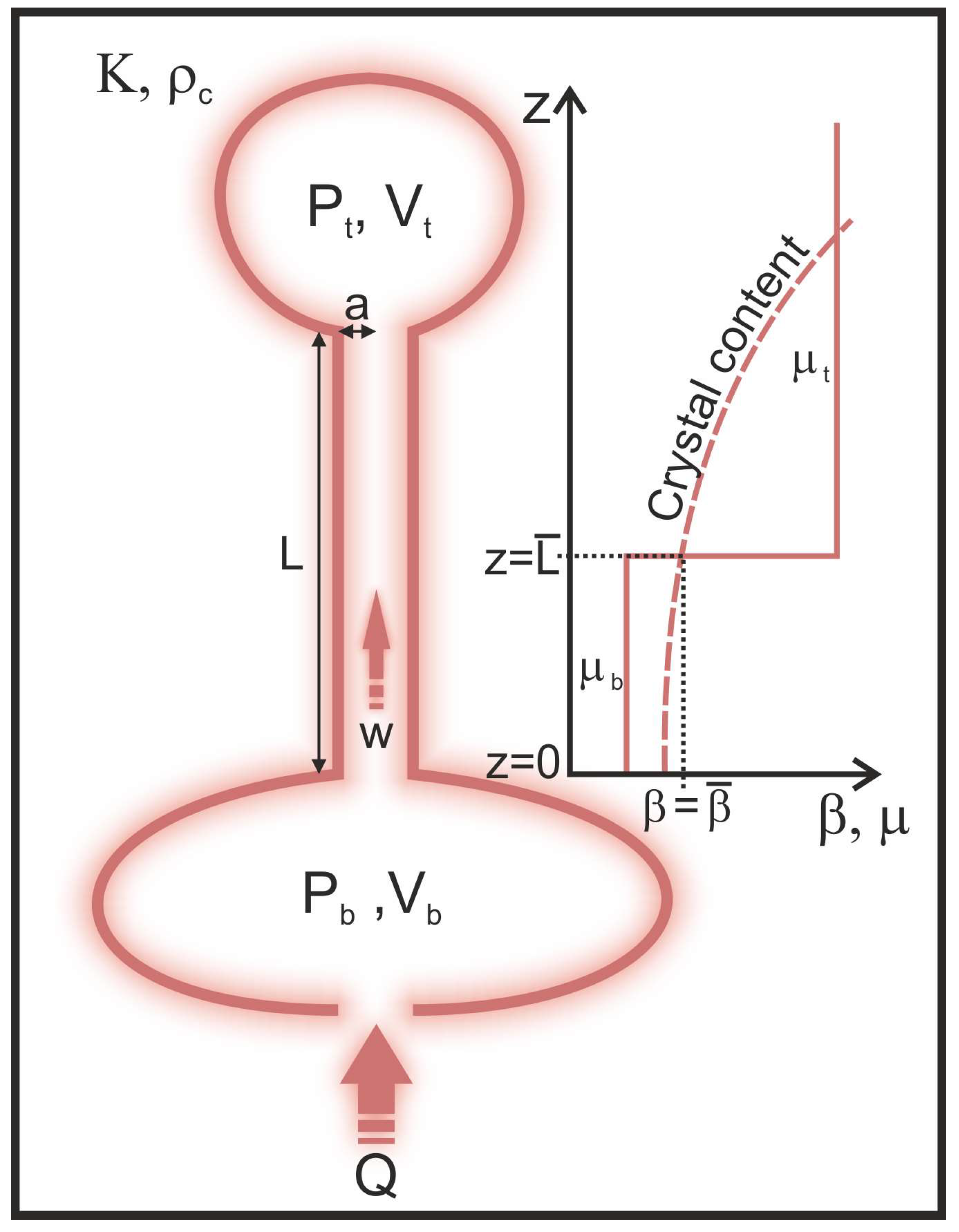




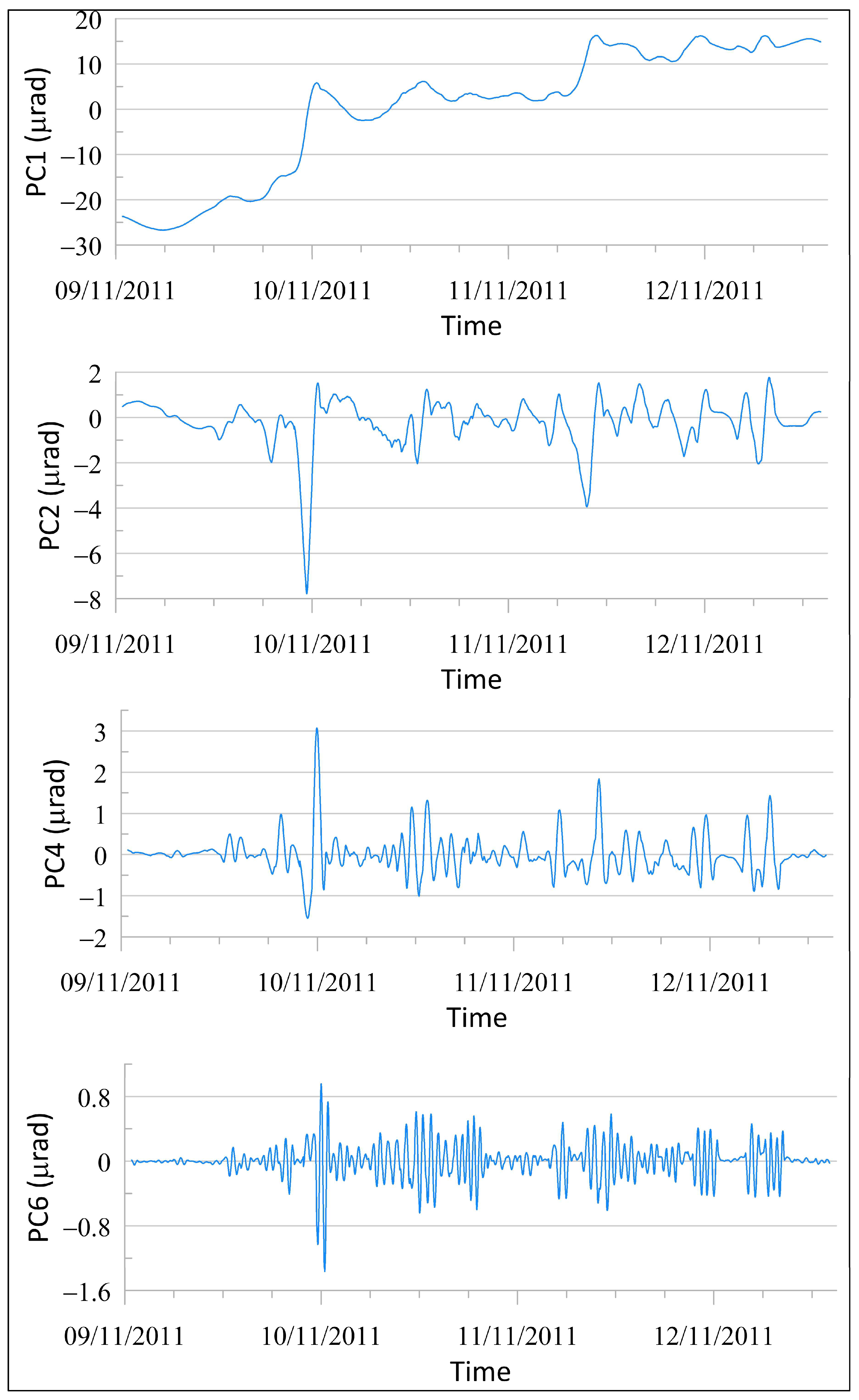
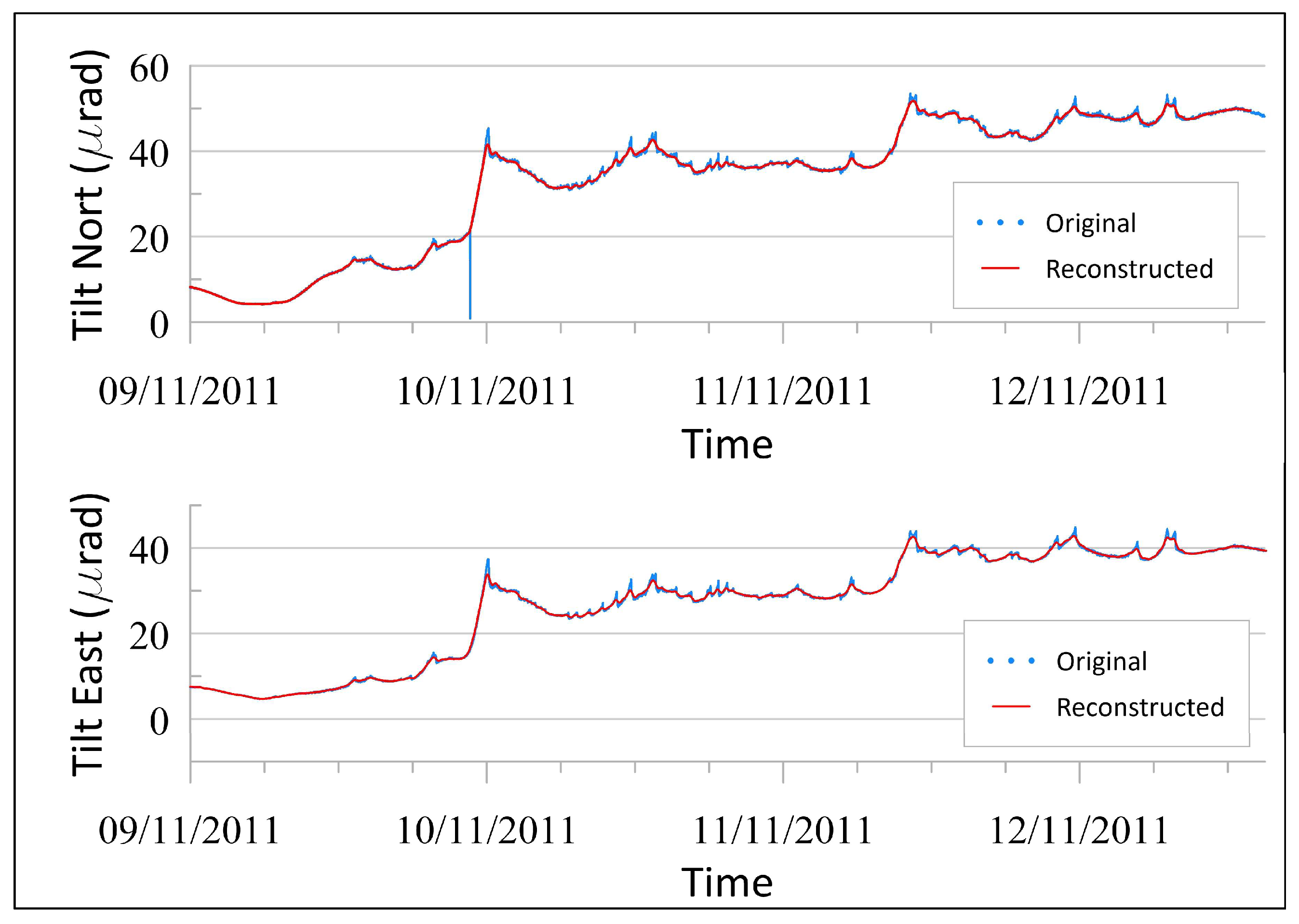
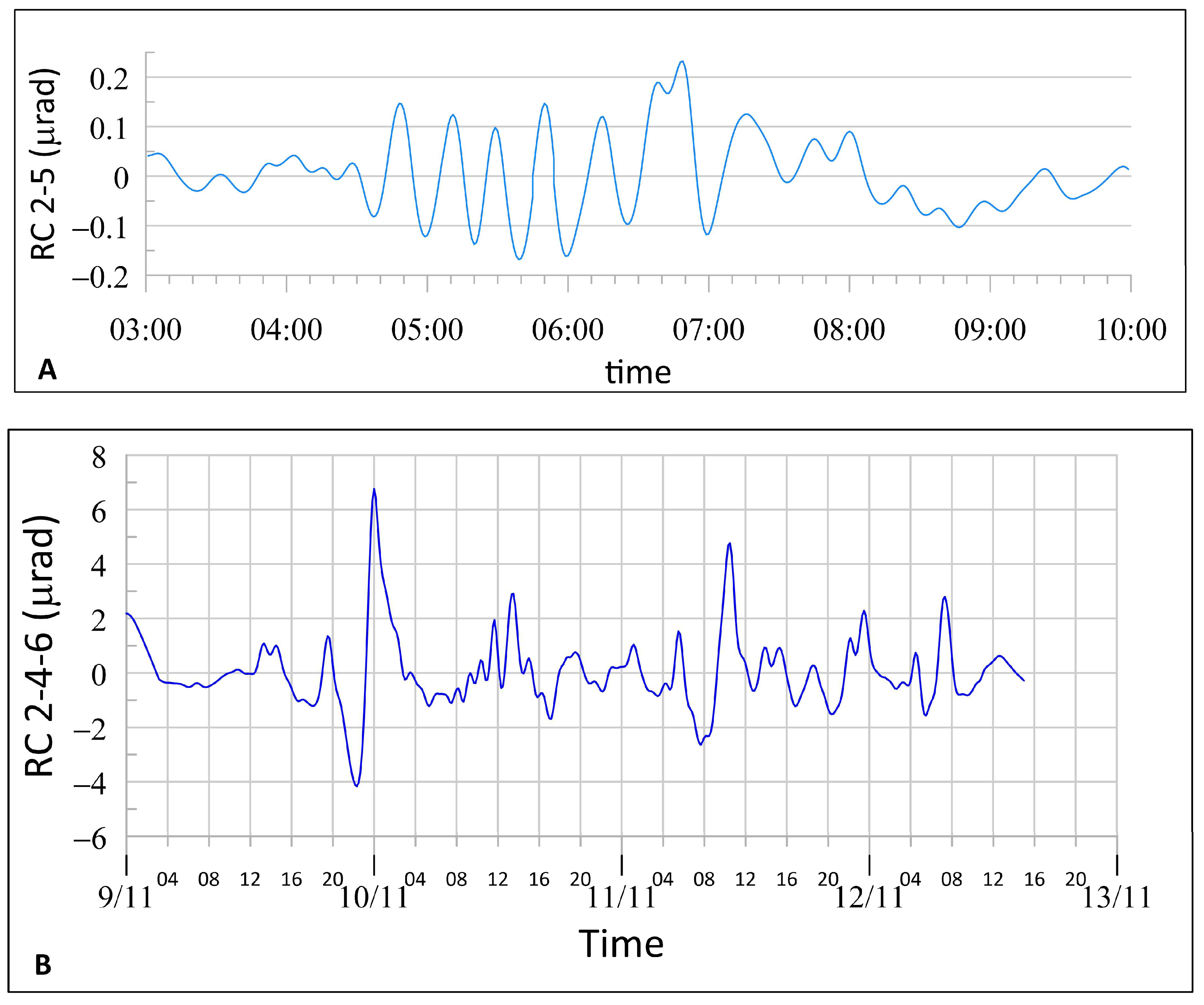


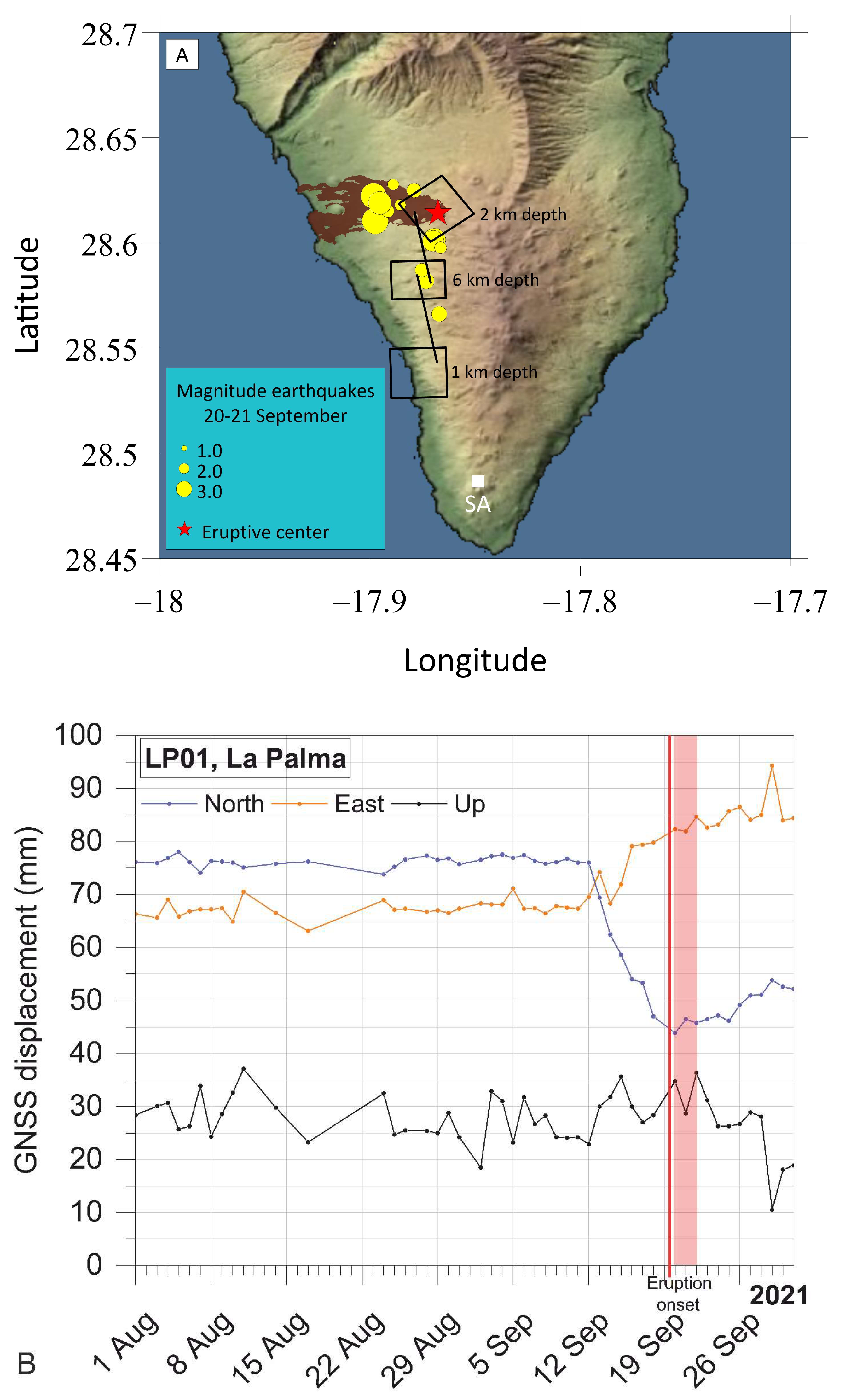


Disclaimer/Publisher’s Note: The statements, opinions and data contained in all publications are solely those of the individual author(s) and contributor(s) and not of MDPI and/or the editor(s). MDPI and/or the editor(s) disclaim responsibility for any injury to people or property resulting from any ideas, methods, instructions or products referred to in the content. |
© 2025 by the authors. Licensee MDPI, Basel, Switzerland. This article is an open access article distributed under the terms and conditions of the Creative Commons Attribution (CC BY) license (https://creativecommons.org/licenses/by/4.0/).
Share and Cite
Gomez-Ortiz, D.; Arnoso, J.; Martín-Velázquez, S.; Martín-Crespo, T.; Montesinos, F.G.; Vélez, E.; Benavent, M. Tiltmeter Data Revealing Transient Magma Viscosity Changes During Eruptions. Remote Sens. 2025, 17, 317. https://doi.org/10.3390/rs17020317
Gomez-Ortiz D, Arnoso J, Martín-Velázquez S, Martín-Crespo T, Montesinos FG, Vélez E, Benavent M. Tiltmeter Data Revealing Transient Magma Viscosity Changes During Eruptions. Remote Sensing. 2025; 17(2):317. https://doi.org/10.3390/rs17020317
Chicago/Turabian StyleGomez-Ortiz, David, Jose Arnoso, Silvia Martín-Velázquez, Tomás Martín-Crespo, Fuensanta González Montesinos, Emilio Vélez, and Maite Benavent. 2025. "Tiltmeter Data Revealing Transient Magma Viscosity Changes During Eruptions" Remote Sensing 17, no. 2: 317. https://doi.org/10.3390/rs17020317
APA StyleGomez-Ortiz, D., Arnoso, J., Martín-Velázquez, S., Martín-Crespo, T., Montesinos, F. G., Vélez, E., & Benavent, M. (2025). Tiltmeter Data Revealing Transient Magma Viscosity Changes During Eruptions. Remote Sensing, 17(2), 317. https://doi.org/10.3390/rs17020317










